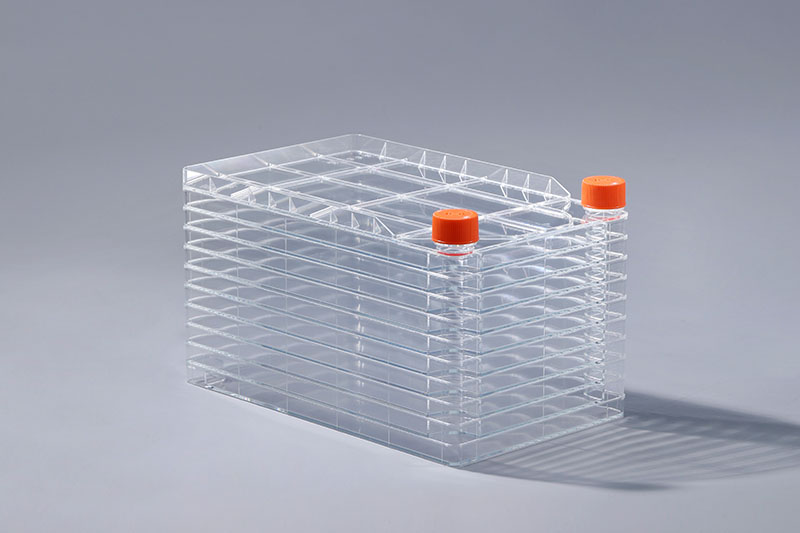বৃহৎ আকারের কোষ সংস্কৃতির জন্য একটি সাধারণ ব্যবহারযোগ্য হিসাবে, ভালো কোষের বৃদ্ধির অবস্থা সহ কোষগুলিকে মাইক্রোস্কোপের নীচে বড় স্বচ্ছতা, শক্তিশালী প্রতিসরণ এবং অস্পষ্ট রূপরেখার সাথে পর্যবেক্ষণ করা যেতে পারে। . কোষের বৃদ্ধির অবস্থা খারাপ হলে, কোষের রূপরেখা বাড়ানো হবে, কোষের প্রতিসরণকারী সূচক দুর্বল হয়ে যাবে, কোষের সাইটোপ্লাজমে ভ্যাকুওল, লিপিড ফোঁটা এবং অন্যান্য দানাদার পদার্থ দেখা দেবে, কোষের মধ্যে ফাঁক বাড়বে, আকৃতি অনিয়মিত হবে। , এবং এমনকি আসল কোষগুলিও হারিয়ে যাবে। বৈশিষ্ট্যগুলি, যার ফলে বৃত্তাকার সংকোচন এবং শেডিং হয়, এবং কখনও কখনও ফিলামেন্টাস ফ্লকগুলি কোষের পৃষ্ঠে এবং তার চারপাশে উপস্থিত হয়৷ আন্দোলনগুলি হালকা হওয়া উচিত, হিংসাত্মক ধাক্কা এড়াতে হবে, পর্যবেক্ষণের সময় খুব বেশি দীর্ঘ হওয়া উচিত নয় এবং পর্যবেক্ষণের সংখ্যা খুব ঘন ঘন হওয়া উচিত নয়, যাতে কোষের বৃদ্ধিকে প্রভাবিত না করে। ভ্যাকসিন উন্নয়ন, জৈব ফার্মাসিউটিক্যালস এবং অন্যান্য ক্ষেত্রে গুরুত্বপূর্ণ ভূমিকা পালন করে। কোষ সংস্কৃতি একটি বিশেষ কাজ। সমস্ত প্রস্তুতি সম্পন্ন হওয়ার পর, প্রতিটি কাজের সাথে সামঞ্জস্য করার জন্য সময়মতো কোষের বৃদ্ধির অবস্থা উপলব্ধি করা প্রয়োজন। 1 স্তর, 2 স্তর, 5 স্তর, 10 স্তর, এবং 40 স্তর। কোষের বৃদ্ধির অবস্থা পর্যবেক্ষণের জন্য সাধারণত একটি উল্টানো মাইক্রোস্কোপের প্রয়োজন হয়, তবে এই যন্ত্রটি সাধারণত শুধুমাত্র কোষ কারখানার 1-10টি স্তর পর্যবেক্ষণের জন্য উপযুক্ত, এবং 1 এবং 2টি স্তরের বৃদ্ধি পর্যবেক্ষণ করতে পারে। নীচের দ্বিতীয় স্তরটি শুধুমাত্র তার কোষগুলির অভিন্নতা পর্যবেক্ষণ করতে পারে এবং এটি চল্লিশটি স্তরের জন্য উপযুক্ত নয়৷ সেল কারখানা পর্যবেক্ষণ করুন। এই ধরনের যন্ত্রগুলিতে সাধারণত দুটি দিকে লেন্স থাকে: পার্শ্ব পর্যবেক্ষণ এবং নীচের পর্যবেক্ষণ। সিস্টেমটি কোষের আকার এবং বৃদ্ধির ঘনত্ব গণনা করতে পারে এবং কোষ কারখানার সমস্ত স্তরে কোষের অবস্থা পর্যবেক্ষণ করতে পারে।
Depending on the culture area, the cell factory consists of one or more layers such as 1 layer, 2 layers, 5 layers, 10 layers, and 40 layers. Observing the growth state of cells generally requires an inverted microscope, but this instrument usually only It is suitable for observing 1-10 layers of cell factories, and can observe the growth of 1 and 2 layers. The bottom second layer can only observe the uniformity of its cells, and it is not suitable for forty layers.
If you want to observe the growth state of cells in more layers of cell factories, you need to use microscopes specially designed to observe cell factories. Such instruments generally have lenses in two directions: side observation and bottom observation. The system can calculate the cell size and growth density, and can observe the state of cells in all layers of cell factories.
Cells with good cell growth state can be observed under the microscope with large transparency, strong refraction, and unclear outline. If the cell growth state is poor, the cell outline will be enhanced, the cell refractive index will be weakened, vacuoles, lipid droplets and other granular substances will appear in the cell cytoplasm, the gap between cells will increase, the shape will be irregular, and even the original cells will be lost. Features, resulting in round shrinkage and shedding, and sometimes filamentous flocs appear on and around the cell surface.
When observing the cells in the cell factory, pay attention to the concept of sterility. The movements should be light, avoid violent shocks, the observation time should not be too long, and the number of observations should not be too frequent, so as not to affect the cell growth.
The FAI climbed 5.9 percent year-on-year in the first 11 months of 2018, quickening from the 5.7-percent growth in Jan-Oct, the National Bureau of Statistics (NBS) said Friday in an online statement.
The key indicator of investment, dubbed a major growth driver, hit the bottom in August and has since started to rebound steadily.
In the face of emerging economic challenges home and abroad, China has stepped up efforts to stabilize investment, in particular rolling out measures to motivate private investors and channel funds into infrastructure.
Friday's data showed private investment, accounting for more than 60 percent of the total FAI, expanded by a brisk 8.7 percent.
NBS spokesperson Mao Shengyong said funds into weak economic links registered rapid increases as investment in environmental protection and agriculture jumped 42 percent and 12.5 percent respectively, much faster than the average.
In breakdown, investment in high-tech and equipment manufacturing remained vigorous with 16.1-percent and 11.6-percent increases respectively in the first 11 months. Infrastructure investment gained 3.7 percent, staying flat. Investment in property development rose 9.7 percent, also unchanged.
 English
English



















































